There are the following:
- The Lighthouse of Alexandria, Alexandria.
 building consisted of a large square base and an octagonal tower 100 feet high. In the top burning wood and resin; that served as a warning light and signal to mariners . For sailors , it meant a sure guide to their returns to Grand Harbour . For architects , it meant even more ; was the tallest building on earth and scientists was mysterious ; had a mirror that fascinated them . The mirror was a reflection could be seen more than 50 km, offshore . Its location is situated on the ancient island of Pharos , now a promontory within the city of Alexandria. Outside the coast of the city is a small island lights, its name, according to legend is a variation of the "Island of the Pharaohs".
The construction of a signal tower was necessary, for centuries, the Lighthouse of Alexandria was used to mark the harbor, using fire at night and reflecting sun rays in a mirror during the day.
building consisted of a large square base and an octagonal tower 100 feet high. In the top burning wood and resin; that served as a warning light and signal to mariners . For sailors , it meant a sure guide to their returns to Grand Harbour . For architects , it meant even more ; was the tallest building on earth and scientists was mysterious ; had a mirror that fascinated them . The mirror was a reflection could be seen more than 50 km, offshore . Its location is situated on the ancient island of Pharos , now a promontory within the city of Alexandria. Outside the coast of the city is a small island lights, its name, according to legend is a variation of the "Island of the Pharaohs".
The construction of a signal tower was necessary, for centuries, the Lighthouse of Alexandria was used to mark the harbor, using fire at night and reflecting sun rays in a mirror during the day. - The Great Pyramid of Giza, Egypt.
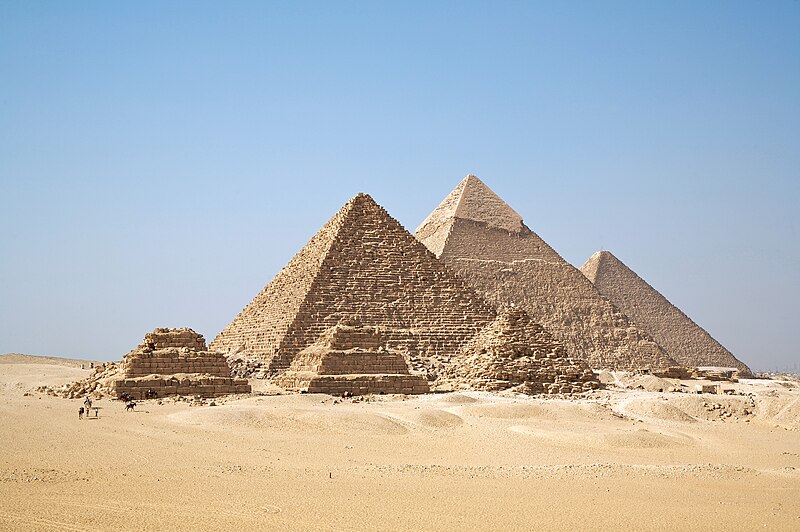 The pyramid is composed of three main chambers, two located inside the pyramid , now called King's Chamber and Queen's Chamber , and underground, underground House . A camera is accessed from the north side by a descending passage , obstructed the end of large blocks of granite, which communicated with two passages , one ascending , which flows into the Grand Gallery , and another down , which leads to the underground chamber . Great gallery . The Grand Gallery is a large ascending passage of about 47 meters long and eight meters tall . The walls of the Grand Gallery are flat to a height of eight feet , from there , staggered , forming a vault approximation of the courses. The House of the king. The King's Chamber is made up of granite slabs and is rectangular , walls , smooth ceiling, decoration, and only contains an empty granite sarcophagus without inscriptions, deposited there during the construction of the pyramid , as it is wider the passages ; on the roof are called discharge chambers , and has the highest ceiling with its large tilted blocks , gable , to deflect pressure from high upper blocks of the pyramid , keeping the weight on the roof download real camera . It is accessed by a horizontal passage called antechamber of the upper end of the Grand Gallery . The House Queen . The Queen's Chamber , so called by the Arabs, but as Mark Lehner and traditional Egyptology, was not used for the king's wife but a Ka statue of himself ( Serdab , interior for containing spiritual representation of the deceased: statue Ka ) is almost situated in the axis of the pyramid ; accessed through a horizontal passage which communicates with the bottom of the Grand Gallery , initially hidden by the paving stones . It is rectangular , smooth walls, undecorated , with a niche , and sloping gable roof. The underground chamber. The underground chamber excavated in the subsoil, is rectangular , with irregular floors, walls and flat roof ; contains two dwellings , for sarcophagi , a well and a small gallery. It is reached by a descending passage , which is an extension of the first hall of the pyramid. Also this statement with the Grand Gallery through a narrow tunnel , almost vertical, drilled in the blocks. The ventilation channels . The ventilation channels : each real camera leave two narrow passages inclined , in the north and south walls , called ventilation channels , for that is its current use , airing by electric drives ; its original function is unknown as the House of the Queen did not communicate with the interior in its last stretch , as they were covered by large granite slabs lining the walls . The House of the King were discovered by R. Howard Vyse , and the House of the Queen W. DixonPyramids are just the typical model royal tomb of the Old Kingdom, and they always have the same inclination or slope; if one some appear with a different structure, it is because they were not completely finished.
The pyramid is composed of three main chambers, two located inside the pyramid , now called King's Chamber and Queen's Chamber , and underground, underground House . A camera is accessed from the north side by a descending passage , obstructed the end of large blocks of granite, which communicated with two passages , one ascending , which flows into the Grand Gallery , and another down , which leads to the underground chamber . Great gallery . The Grand Gallery is a large ascending passage of about 47 meters long and eight meters tall . The walls of the Grand Gallery are flat to a height of eight feet , from there , staggered , forming a vault approximation of the courses. The House of the king. The King's Chamber is made up of granite slabs and is rectangular , walls , smooth ceiling, decoration, and only contains an empty granite sarcophagus without inscriptions, deposited there during the construction of the pyramid , as it is wider the passages ; on the roof are called discharge chambers , and has the highest ceiling with its large tilted blocks , gable , to deflect pressure from high upper blocks of the pyramid , keeping the weight on the roof download real camera . It is accessed by a horizontal passage called antechamber of the upper end of the Grand Gallery . The House Queen . The Queen's Chamber , so called by the Arabs, but as Mark Lehner and traditional Egyptology, was not used for the king's wife but a Ka statue of himself ( Serdab , interior for containing spiritual representation of the deceased: statue Ka ) is almost situated in the axis of the pyramid ; accessed through a horizontal passage which communicates with the bottom of the Grand Gallery , initially hidden by the paving stones . It is rectangular , smooth walls, undecorated , with a niche , and sloping gable roof. The underground chamber. The underground chamber excavated in the subsoil, is rectangular , with irregular floors, walls and flat roof ; contains two dwellings , for sarcophagi , a well and a small gallery. It is reached by a descending passage , which is an extension of the first hall of the pyramid. Also this statement with the Grand Gallery through a narrow tunnel , almost vertical, drilled in the blocks. The ventilation channels . The ventilation channels : each real camera leave two narrow passages inclined , in the north and south walls , called ventilation channels , for that is its current use , airing by electric drives ; its original function is unknown as the House of the Queen did not communicate with the interior in its last stretch , as they were covered by large granite slabs lining the walls . The House of the King were discovered by R. Howard Vyse , and the House of the Queen W. DixonPyramids are just the typical model royal tomb of the Old Kingdom, and they always have the same inclination or slope; if one some appear with a different structure, it is because they were not completely finished.- The Temple of Artemis, Turkey.
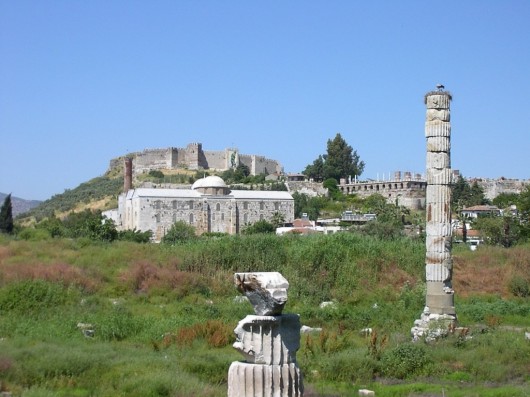 One of the most important features that can still be seen in the Temple of Artemis is a column that is the only one that survives, and reveals the immensity that had this place in the past, it became four times larger than the Parthenon, and the first building of this size to be built entirely of marble worldwide. This temple contained a lot of spectacular art pieces, among which were several Greek artists sculptures, paintings and carved with silver and other columns. Some of these pieces can be seen in the British Museum, so the only thing you can see on the site are the ruins of the whole structure. We recommend going there in the summer months, because everything looks much better, because the surrounding marsh is at its lowest level and get to see the foundations of the buildings that were.
One of the most important features that can still be seen in the Temple of Artemis is a column that is the only one that survives, and reveals the immensity that had this place in the past, it became four times larger than the Parthenon, and the first building of this size to be built entirely of marble worldwide. This temple contained a lot of spectacular art pieces, among which were several Greek artists sculptures, paintings and carved with silver and other columns. Some of these pieces can be seen in the British Museum, so the only thing you can see on the site are the ruins of the whole structure. We recommend going there in the summer months, because everything looks much better, because the surrounding marsh is at its lowest level and get to see the foundations of the buildings that were.- The Statue of Zeus, Olympia
 classical antiquity was inside and was the statue of Zeus.The statue of Zeus, made in 432 BC, in crisoelefantina (gold and ivory) , had a height of 12 meters, so it should almost fill the entire interior of the temple. His presence was impressive, giving the temple an insignificant aspect was made in ivory and was sitting on a throne of ebony , ivory, gold and adorned with precious stones. This throne was also decorated with various reliefs relating to Greek mythology . A tunic or robe of gold caia on legs partially tapaban Zeus . The look of the father of the gods was heading down attitude of looking to the faithful who were on their feet. On the available head an olive wreath in her left hand was holding a small figure of a ' Nike " (the goddess of victory) , alluding to the winners of the Olympic Games and in his right hand he held a scepter topped by figure of an eagle , his personal emblem.The fate of the statue is unknown, in the V century AD Christians burn the temple ; according to some versions the statue disappears in the fire , according to others it had been carried to Constantinople to save for what might happen, but in that city his trail is lost and never has been heard of her.Olympia excavations have been made in the temple and found no traces of it , so it may well be that it disappeared during his stay in Constantinople.
classical antiquity was inside and was the statue of Zeus.The statue of Zeus, made in 432 BC, in crisoelefantina (gold and ivory) , had a height of 12 meters, so it should almost fill the entire interior of the temple. His presence was impressive, giving the temple an insignificant aspect was made in ivory and was sitting on a throne of ebony , ivory, gold and adorned with precious stones. This throne was also decorated with various reliefs relating to Greek mythology . A tunic or robe of gold caia on legs partially tapaban Zeus . The look of the father of the gods was heading down attitude of looking to the faithful who were on their feet. On the available head an olive wreath in her left hand was holding a small figure of a ' Nike " (the goddess of victory) , alluding to the winners of the Olympic Games and in his right hand he held a scepter topped by figure of an eagle , his personal emblem.The fate of the statue is unknown, in the V century AD Christians burn the temple ; according to some versions the statue disappears in the fire , according to others it had been carried to Constantinople to save for what might happen, but in that city his trail is lost and never has been heard of her.Olympia excavations have been made in the temple and found no traces of it , so it may well be that it disappeared during his stay in Constantinople.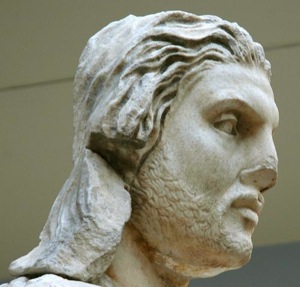 |
| The sculpture of Mausolus |
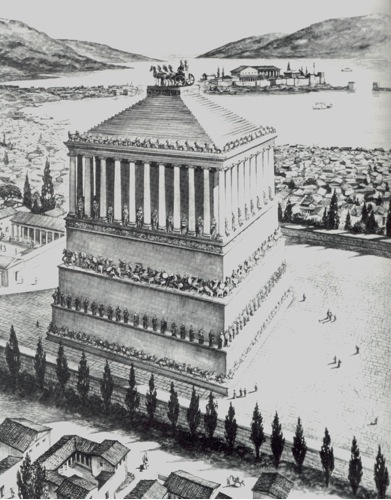 The result was nothing less than one of the Seven Wonders of the Ancient World , as cataloged Antipater of Sidon. The building was designed by famous architects and Pittheus and Satiro , inspired by traditional Anatolian and Greek architecture. Although the mausoleum was built with bricks , they were covered with white marble island Proconnesian (Sea of Marmara ) , with splendid finishes. The impressive monument posthumously made famous in his time and was copied many times. It is very likely that the architecture of the tomb of Alexander the Great in Alexandria was inspired by Halicarnassos building , which became known as " the mausoleum". From the base to the ceiling, there was a large structure ( 32 × 26 meters) a platform surrounded by 36 columns ( the Pteron ), and in the next platform, a pyramid equal in height to the building that supported it , 24 steps, that they were shaking as the pyramid rose . Finally , the pyramid was topped by a life-size sculpture of a chariot horses, some of which still survives today. The Mausoleum was a total of 50 meters.
The result was nothing less than one of the Seven Wonders of the Ancient World , as cataloged Antipater of Sidon. The building was designed by famous architects and Pittheus and Satiro , inspired by traditional Anatolian and Greek architecture. Although the mausoleum was built with bricks , they were covered with white marble island Proconnesian (Sea of Marmara ) , with splendid finishes. The impressive monument posthumously made famous in his time and was copied many times. It is very likely that the architecture of the tomb of Alexander the Great in Alexandria was inspired by Halicarnassos building , which became known as " the mausoleum". From the base to the ceiling, there was a large structure ( 32 × 26 meters) a platform surrounded by 36 columns ( the Pteron ), and in the next platform, a pyramid equal in height to the building that supported it , 24 steps, that they were shaking as the pyramid rose . Finally , the pyramid was topped by a life-size sculpture of a chariot horses, some of which still survives today. The Mausoleum was a total of 50 meters. The architects wrote a book about the monument that they created. This book was known in Roman times by authors such as Pliny the Older, in his chronicles that provides a brief description of its contents. Pliny says four famous sculptors participated in the construction of the Mausoleum Halicarnassos: Scopas, Briaxis, Tomoteo and Leochares, who were responsible for the decoration on the east, north, south and west,
respectively. They carved reliefs of Amazons bright (theme amazon) as a famous battle between Greeks and Amazons soldiers.
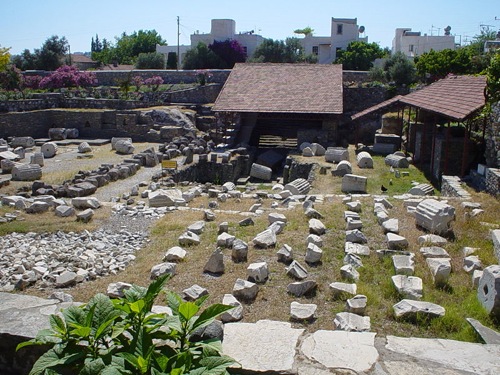 |
| Mausolus now a day. |
Today, the remains of this once great monument featuring a sad stamp. The site already suffered in ancient times, but in the Middle Ages still impressed. In 1522, the Knights of Rhodes destroyed to the last stone and many of their remains used in the construction of Bodrum Castle.
- The Colossus of Rhodes, Greece.
In 277 BC, the last of the wonders of the ancient world is built. In the Aegean Sea, about 18 km from the coast , we find the most important of the Sporades islands : Rhodes. It is important because their city of the same name , is the capital of the Dodecanese archipelago comprising
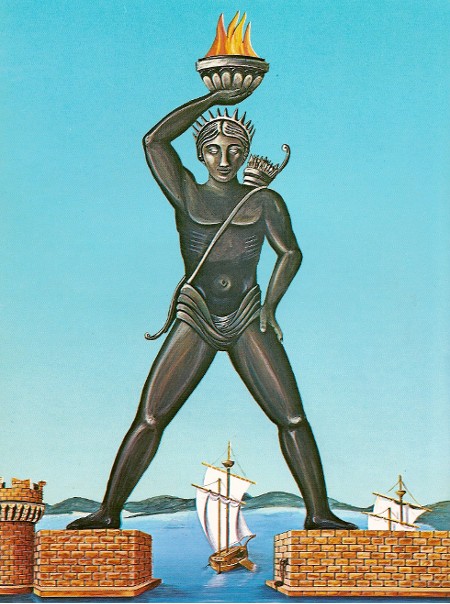 twenty islands. The geographical location of Rhodes is privileged to trade with Greece , Asia Minor and even Egypt, and because of that it has become the most important commercial center in the Eastern Mediterranean . City decides to raise a memorable monument to Helios , the sun god, in the harbor. The statue grows , first the iron frame and bronze plaques him . Finally , when the statue is completed measures no less than 32 meters. His fame will attract travelers from all over the ancient world to view. With the Colossus , became the world's wonders five that rose on the face of the earth, that number was not surpassed but was decreasing. 56 years after its construction , in 223 BC , an earthquake toppled the Colossus. The inhabitants of Rhodes, on the advice of an oracle , decided to leave his remains lie where they fell.During the Renaissance the Colossus was "discovered" by the humanists , like the rest of Greek art and its magnificence was being circulated that highlighted its size was such that ships passed between its legs. But the Colossus does not need mitificación : be spending a whopping 2,000 years until man make another colossal statue that exceeded.
twenty islands. The geographical location of Rhodes is privileged to trade with Greece , Asia Minor and even Egypt, and because of that it has become the most important commercial center in the Eastern Mediterranean . City decides to raise a memorable monument to Helios , the sun god, in the harbor. The statue grows , first the iron frame and bronze plaques him . Finally , when the statue is completed measures no less than 32 meters. His fame will attract travelers from all over the ancient world to view. With the Colossus , became the world's wonders five that rose on the face of the earth, that number was not surpassed but was decreasing. 56 years after its construction , in 223 BC , an earthquake toppled the Colossus. The inhabitants of Rhodes, on the advice of an oracle , decided to leave his remains lie where they fell.During the Renaissance the Colossus was "discovered" by the humanists , like the rest of Greek art and its magnificence was being circulated that highlighted its size was such that ships passed between its legs. But the Colossus does not need mitificación : be spending a whopping 2,000 years until man make another colossal statue that exceeded.- The Hanging Gardens of Babylon, Iraq.
The Hanging Gardens of Babylon were one of the Seven Wonders of the Ancient World and the only one whose location has not been definitively established.Traditionally said to have been built in the ancient city of Babylon , near present- Hilla , Babil Province , Iraq. The Babylonian priest Berossus , writing in about 290 BC and later cited by Josephus , attributed gardens Babylonian King Nebuchadnezzar II , who ruled between 605 and 562 BC. Awkwardly , no existing Babylonian texts that mention the gardens , and there is no definitive archaeological evidence has been found in Babylon. Due to the lack of evidence, it has been suggested that the hanging gardens are purely legendary and descriptions found in ancient Greek and Roman writers as Strabo , Diodorus and Quintus Curtius Rufus represent a romantic ideal of an Oriental garden.
Ancient texts.In ancient writings the Hanging Gardens of Babylon were first described by Berossus , a Babylonian priest Marduk , who wrote around 290BC , but his books are known only by quotations from later writers ( Josephus ) . There are five main writers (including Berossus ) the disclosures of Babylon are preserved in some form today. These writers are concerned about the size of the Hanging Gardens , why and how they were constructed and how the gardens are irrigated .
There is some controversy as to whether the Hanging Gardens were an actual building or a poetic creation due to the lack of documentation in contemporary Babylonian sources. There is also no mention of the wife of Nebuchadnezzar Amyitis (or any other wife). Herodotus, writing about Babylon, closer in time of Nebuchadnezzar II, does not mention the hanging gardens in their Historias.Hasta date, no archaeological evidence has been found in Babylon in the Hanging Gardens. There may be evidence on the Euphrates, which can not be excavated safely today. The river ran east of its current position in the time of Nebuchadnezzar II, and little is known about the western part of Babylon. Rollinger has suggested that Berossus attributed Gardens of Nebuchadnezzar, for political reasons, and had adopted the legend elsewhere.
It´ a good entry! Thank for the info!
ResponderEliminarIncredible buildings and very beautiful places
ResponderEliminar